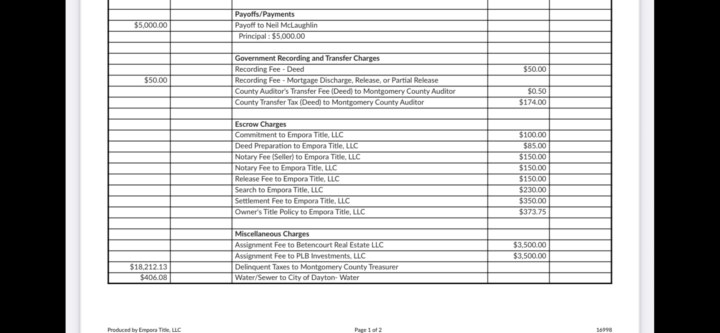Hello Real Estate Resultz Producers! Introduce yourself and share some goals!
Hello Real Estate Resultz Producers! Real Estate Resultz is dedicated to sharing real life behind the scenes of modern day real estate wholesaling. My name is Kyle Banghart and I've been doing a variety of deals since 2014. I'm committed to helping people take their initial steps into low risk (ideally low capital) investment strategies including but not limited to wholesaling, seller financing, HML-based purchases. I personally had a power strategy that I used 20 times between 2015 and 2019 and that is wholesaling TO MYSELF! I would find a deal and prepare a wholesale closing with the title co. and at the same time I'd prepare HML funding and then go raise private funds for the closing and carrying costs. I would tell everyone involved I am taking a wholesale fee on the way into the deal and I would be in those deals with 100% NONE OF MY OWN MONEY. At most I would pay to create the LLC. ;-) I am passionate about helping others see possibilities they didn't see before and make a roadmap and action plans to success. Introduce yourself and share some of your goals for this year or next year!
You procrastinate because your survival isn’t at stake.
I was just reading this brilliant writer and sharing my fav. part... What do you all think about this: Animals survive and reproduce on the physical level. They attempt to reproduce the information in their genes. Humans do as well, but we live in such a world that physical threats are rare. We mostly survive on the psychological level and attempt to reproduce the information in our consciousness. - We attach to political ideologies, feel threatened, and lash out when the “other side” attacks our beliefs. - We adopt beliefs and worldviews as our identity, like being a “gamer,” and when someone says that’s bad, it’s like you were slapped in the face (psychologically) and you want to fight back. - When you attempt to change your life, like being more productive, you threaten the relevant identity that doesn’t want you to do that (like being a good student or employee). If you learn to transcend and leverage your survival instincts, your productivity shoots through the roof. You need to change your identity by changing the stubborn beliefs and normative prescriptions (what you’re “supposed” to do from your parents, teachers, and authorities). You change your identity by changing your environment. To be more productive, force yourself into physical and digital locations that make you feel like you don’t yet belong. 🔥 Follow people with the goals you want to pursue, the beliefs that your future self could benefit from, and the knowledge that allows you to achieve clarity. 🔥 When you are a person who works toward their goals, discipline becomes seamless, and you feel threatened when you are not doing so, giving you an energy source to act toward something greater.
1
0
The Hidden Cost of Back-to-Back Meetings: Why High-Level Executives Need Buffer Time
In the relentless pace of executive life, back-to-back meetings have become the norm, a badge of busyness that signals productivity. Yet, for CEOs, performers, and other high-level leaders, this scheduling trap is a silent saboteur. It leaves no room for the mental whitespace required to transform raw information into strategic action. Buffers—those intentional 10- to 15-minute gaps between commitments—aren't luxuries; they're essential for cognitive recovery and high-stakes decision-making. Without them, executives risk turning into mere meeting moderators, reactive rather than visionary. High-level execs don't just attend meetings; they own them. This demands a multifaceted skill set: pre-meeting preparation to frame agendas and anticipate challenges, in-meeting mastery to steer discussions toward outcomes, and post-meeting synthesis to distill insights. The brain of a CEO operates at peak complexity, juggling interconnected threads of strategy, team dynamics, and market shifts. Rushing from one call to the next overloads working memory, impairing judgment and innovation. Research from cognitive science underscores this: without pauses, information overload leads to decision fatigue, where even the sharpest minds default to autopilot. Buffers restore clarity, allowing leaders to shift from absorption to analysis. These interstitial moments are where true value emerges. In a buffer, an exec can capture fleeting thoughts—jotting key takeaways, flagging action items, or sketching follow-ups—before they evaporate. This isn't passive downtime; it's active processing that bridges the gap between hearing and doing. For instance, a 15-minute window might reveal a pattern across discussions, sparking a pivotal pivot in company direction. High performers thrive here, using buffers to prioritize ruthlessly: What requires immediate response? What can delegate? Without this ritual, meetings devolve into echo chambers of half-remembered ideas, eroding the executive's ability to act decisively and drive results.
1
0
Congratulate Patrick on his first deal!
@Patrick Brown is a new member who did a deal prior to joining this community. In his own words, "Hello I’m Patrick, I’m in the ideal of building connections and networking with people who understand growth, commitment, and what to improve their own skill set as a real estate professional. Been in real estate for about 5 years now and just last year started taking action after my first deal happened in August 2024. One year later I just been doing marketing and VA services." "I know VA services can get expensive but over the last year or so I been able to make some really cool partnerships. Let me know when I can bring it up in discussion I don’t mind sharing my experience with it." "the first deal I closed was a wholesale deal I made about $7,000. However, when I first started I did it all by cold calling and working with a partner. It took about 6 months before I found a deal to close. It was a tax delinquency property in Dayton OH. The owner owed about $20,000 in debt and was a tired landlord. We was able to help him settle the debt with the lender for $5,000 and sell his property to a retail buyer at $70,000. The deal was stagnant for about a few days before closing because no one could find the lender. I skipped traced his information from county records and after calling 20 associated numbers over an hour, I got a call back from him and was able to get the paperwork signed to move forward. My partner and me made $3500. My company name is PLB Investments LLC. That day made wholesaling a reality and the push I needed to keep going." I asked if he'd be willing to share some details about his experiences in marketing and VA services for next weeks interactive discussion and he's planning to join us for that! Wednesday 10/8/2025 @ 5:30pm EST Here is the zoom link for that: https://us06web.zoom.us/j/82013397445?pwd=sK6G2bRLA8Sby1FLoPoQ1r7AaVTweE.1 @Maria Dattilo @Victoria Banghart @Rick Hansen @Aaron Roman @Levi Klein @Lydie Molina @Helma Klara @Keith Sanders @Tobi Samuel

Welcome New Members!
Happy to have you join the Real Estate Resultz Community. @Patrick Brown @Tobi Samuel @Levi Klein @Maria Dattilo @Helma Klara @Aaron Roman We have a weekly interactive discussion on Wednesday 5:30pm EST. This is for fun and entertainment and to stimulate growth and relationship building. Occasionally I do full-immersion real estate investor working sessions where I'll share my screen and audio while I am doing some aspect of real estate investor work cycle. Our primary focus here is to provide full immersion experiences, accountability and hands on training and profit share opportunities. Soon I'll launch live classes where I'll teach the courses I'm offering. Most of these courses havent been recorded yet and the videos will go up after we record. Please introduce yourself. Sharewhat you are looking for from the community and how we can support you! Check out the calendar events and make some comments and posts on other peoples posts! @Lydie Molina @Victoria Banghart @Rick Hansen

1-17 of 17
powered by

skool.com/real-estate-resultz-5062
Dive into Real Estate Resultz! Connect with mentors & peers, master lead gen & deals through Deal Sessions & Masterminds. Act, learn, succeed!
Suggested communities
Powered by


